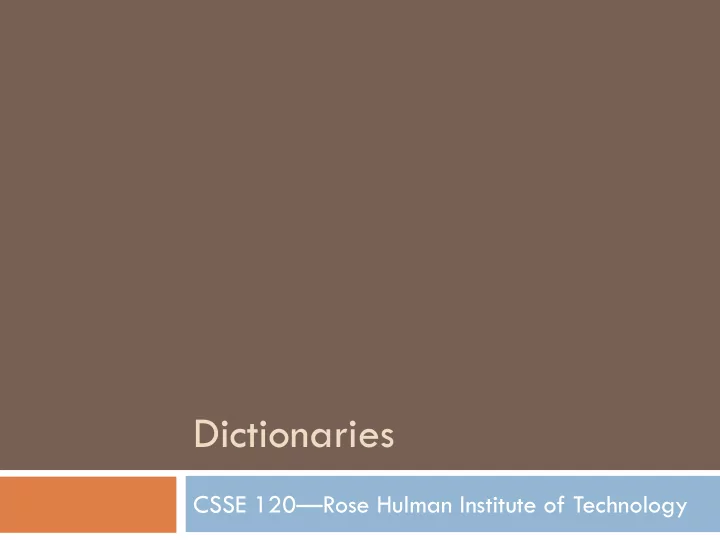

Dictionaries CSSE 120 — Rose Hulman Institute of Technology
Data Collections Frequently several individual pieces of data are related We can collect them together in one object Examples: A list or tuple contains an ordered sequence of items A string contains an ordered sequence of characters A custom object. Example from zellegraphics: A Line object contains two endpoints, a color, and the window in which it is drawn A dictionary (defined soon) contains key-value pairs
List - review An ordered collection of items Usually homogeneous (all items of the same type), but Python does not require this Access is by position (index) in the list >>> animals = ['dog', 'cat', 'cow'] >>> animals[1] 'cat' >>> animals[1:3] ['cat', 'cow'] Lists can be mutated : elements changed, deleted, added >>> animals[1] = 'pig' >>> animals.append('horse') >>> animals >>> animals ['dog', 'pig', 'cow'] ['dog', 'pig', 'cow', 'horse'] Q1
Dictionary A collections object in which each item is a key-value pair No two items may have the same key So a dictionary is a function (in the mathematical sense) 0 1 2 ‘name’ ‘phone’ x[0] x[1] x[2] d[‘name’] d[‘phone’] ‘hi’ ‘bye’ ‘ok’ ‘ cynthia ’ ‘900 - 8888’ Items are not stored in any particular order Typically all keys are same type (not required) Keys must be immutable (i.e., string, number, tuple of strings and/or numbers) Access to items is by key key's purpose is similar to list's index syntax also similar
Dictionary operations Create a new dictionary d = {} d = {‘name’ : ‘bob’, ‘age’ : 19, ‘ gpa ’ : 3.1} Access a dictionary value associated with a given key d[‘age’] Modify a dictionary value associated with a given key d[‘age’] = 20 Add a new key/value pair to the dictionary d[‘major’] = ‘be’ Delete a key/value pair from the dictionary del d [‘ gpa ’] Determine whether a given key is in the dictionary Q2-6 ‘year’ in d
Two main dictionary uses The dictionary is associated with a single object and stores attributes of the object, all under the single name of the dictionary Example: The student dictionary from the quiz. It is associated with a particular student and stores that student’s name, age, weight, and so forth. Often we store a list of these dictionaries, e.g. a list of student dictionaries, one for each student in the class. A collection of similar objects Designed for fast lookup by key Examples: A movie database in which we use the title as the key and look up the director. A phone database in which we use the person’s name as the key and look up the phone number. Q7-8
Exercises on dictionaries and lists Checkout 22-Dictionaries Begin the TODO’s in dictionariesUse1.py You’ll finish them for homework Do the TODO’s in dictionariesUse2.py Rest of class: examine the Exam 2 topics document (from Schedule page, session 22). Ask questions. Start working problems. Make a crib sheet. Q9
Recommend
More recommend